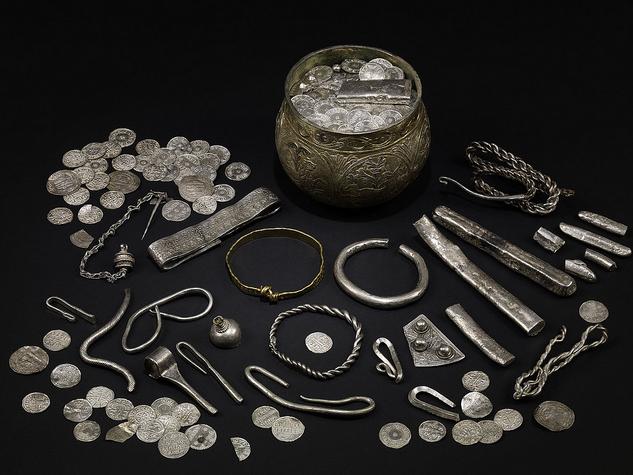This summer “VIKING 2013” presents us with four angles on the Vikings. The first one is about Material Cultural Contacts and Trade…
One of the more persistent characteristics of the artefacts found in Viking burials and archaeological excavations of their towns, farms and manors, is the reworking of the imported goods. Thus bejewelled clasps from codices or trefoil mounts have been found reworked into brooches, while traditional Irish brooches were copied but with a slight Viking touch in the form of a different artistic expression. At the same time silk was imported from China, but primarily cut up into strips and used as borders on the traditional tunics and dresses, while Vikings in the East experimented with a more oriental look as witnessed by the clothes found in the graves in Birka. Less prominent – but more often found – was the fashion by which silver coins were fitted with loops or just had holes bored into, in order for the man or woman to dangle these from their jewellery or hair-fillets.
Such goodies and many more types of trinkets – slaves, whetstones, fur, ivory, amber, wool and cloth, pottery, glass, textiles, weapons and jewels – were brought for sale in towns and marketplaces by long-distance tradesmen and exchanged for other goods, silver or weighted coins. A somewhat limited trade took definitely place already in the 8th century, but there is no doubt it intensified in the next centuries. The Vikings were to all intents and purposes determined to fulfil their curiosity about other people and cultures by any means – partaking in discoveries, travelling as tradesmen from East to West, visiting local markets or just by simple plunder. Although two artefacts muddle this multicultural construction of the identity of the Vikings – the swords and the oval brooches, the traditional Viking jewellery of the women – the Vikings must be considered a truly internationally oriented band of not only pirates but also tradesmen and warriors. Material Viking Culture was simply heavily inspired by the international connections fostered through not only plunder, but also trading ventures.
Read the general presentation and review of the exhibition Viking 2013
Read about the different sections of the exhibition here:
